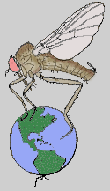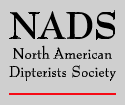
| Home | Family Key | | |||
![]()
Diptera Associated with Livestock Dung
Identification Table for Major Filth Fly Pests
| Location |
adults usually in open pastures; generally on host animal |
adults common in confined facilities and also in open pastures |
adults outdoors, usually on host animal around eyes and muzzle; in buildings during fall and winter |
adults common in confined facilities and buildings |
| Behaviour |
both sexes bite (not man) |
both sexes bite (including man) |
does not bite |
does not bite |
| Biology |
breeds only in fresh cattle dung |
breeds in dung and decaying organic matter |
breeds only in fresh cattle dung |
breeds in dung and decaying organic matter |
| Adult |
4-5 mm long; gray with 2 dark stripes on thorax, abdomen with diffuse marks; extended piercing proboscis and long palps |
5-8 mm long; gray with 4 dark stripes on thorax, abdomen with dark spots; long slender piercing proboscis and short palps |
7-8 mm long; gray with 4 dark stripes on thorax, abdomen dark gray-black in female, orange at sides in male; fleshy mouthparts; eyes almost touching in male |
5-8 mm long; gray with 4 dark stripes on thorax, abdomen yellowish at sides; fleshy mouthparts; eyes well separated in male |
| Egg |
without terminal respiratory horn |
without terminal respiratory horn |
||
| Larva (3rd instar) and Puparium |
2 narrowly separated D- shaped posterior spiracles; puparium brown |
2 widely separated subtriangular- shaped posterior spiracles; puparium brown |
2 narrowly to moderately separated nearly circular D-shaped posterior spiracles; puparium whitish |
2 moderately separated nearly circular D-shaped posterior spiracles; puparium brown |
Filth fly web pages developed by
J.M. Cumming and B.E. Cooper
First published on the Internet in 1998
Last updated 18 May 2006 by J.M. Cumming and G.D. Murray
